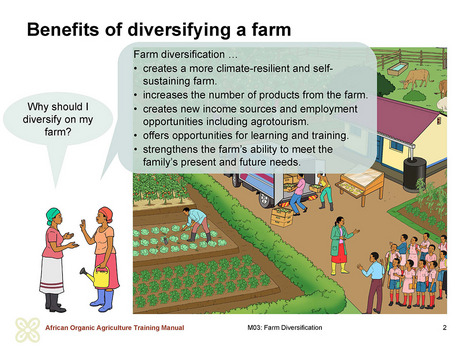Definition and advantages of farm diversification
Diversification on a farm means producing different crop and plant varieties or species; adding farm animals or different animal types and breeds to the farm; and/or additionally engaging in non-agricultural activities to increase outputs from the farm while mitigating production risks. Thus, diversification can take place at any, or all, of the following three levels:
- adding new crop varieties or plant species to existing crop enterprises or new animal breeds or types to existing livestock enterprises,
- integrating crop and livestock enterprises, and
- adding non-agricultural complementary activities to improve farm outputs.
Farm diversification has the following advantages:
- Reduces risk of loss due to climate, pests, and diseases or other natural and man-made hazards. This is consistent with the common expression “don’t put all your eggs in one basket”, which means that a farmer should not concentrate or commit all resources to one enterprise because if it fails, everything is lost. But when the farmer has different enterprises, when one is affected, the remaining ones can sustain the farm.
- Guarantees higher farm productivity and income by reducing dependence on few outputs. Overall farm output from alternative farm enterprises will be higher, and thus income will also improve while overall production costs will reduce when the farm diversifies into carefully selected enterprises which share farm resources. This is called the farm economies of scale, i.e. using the same labour for a higher amount of outputs. Diversification can also manage price risk, on the assumption that not all products will suffer same market price changes.
- Provides additional employment opportunities. The introduction of additional crop and or livestock enterprises including value addition through processing activities or other non-agricultural activities implies that labour opportunities also expand, positively contributing to the local economy.
Irrespective of the diversification target (crops/plants, livestock, or complementary non-agricultural enterprises), the farm should strive to contribute to at least one of the three overarching goals of reducing risk, increasing farm productivity or creating employment opportunities. Ultimately, the goal of diversification is to achieve a balanced farm engaged in different complementary activities that present different income streams to meet the needs of the farmer today and in the future.
The introduction of new farm enterprises may come with new demands on farm resources, management time and skills. Farm diversification is not different from any other business and thus the new enterprise may fail, not always due to lack of planning, but some fail due to timing. Others may fail because consumers’ tastes change before the enterprise reaches maturity to start producing outputs. Therefore, certain parameters (section 3, page 15 of this guide) should be considered when selecting the enterprises to diversify into.
Brainstorming on opportunities and risks of diversification
Ask the trainees what opportunities and risks they see when thinking about diversification on their farms. Note the answers on a board. You can come back to the answers after the presentation of the topic and ask the participants if they see the risks and opportunities differently.



 tap and then scroll down to the Add to Home Screen command.
tap and then scroll down to the Add to Home Screen command.